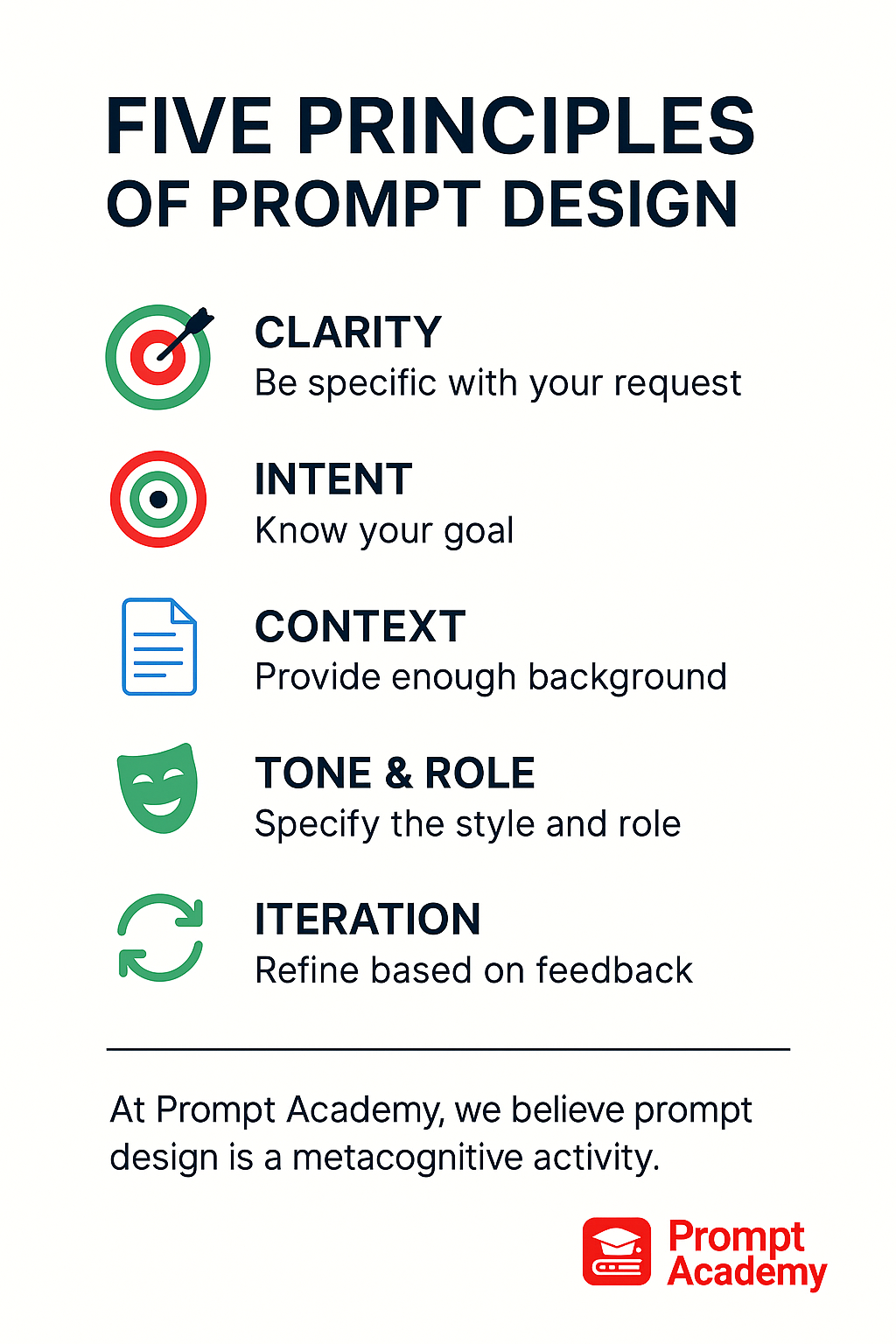A good prompt is not about magic words — it’s about clarity of thought. The Prompt Design Guide empowers educators, students, and researchers to craft effective prompts through intention, structure, and iteration. This is not a template bank, but a mindset for meaningful human–AI interaction.

🎯 Five Principles of Prompt Design
Effective prompting is more than knowing what to say — it’s about knowing how to think. These five principles guide you in designing prompts that are clear, purposeful, and iterative, making AI a tool for thinking, not just generating.
1. 🧭 Clarity – Be Specific With Your Request
The more precise your question, the better the AI can respond. Avoid vague phrases like “explain this” unless you’re exploring broadly. Instead, guide the AI clearly: “Summarise this paragraph for a young reader.” or “List three challenges of AI-aware assessment.” Clarity reduces confusion and sharpens your own thinking — just like writing a good research question.
2. 🎯 Intent – Know Your Goal
Are you asking the AI to summarise, critique, rewrite, or reflect? Your prompt should reflect that goal. For example: “Turn this into a persuasive paragraph,” or “Suggest research questions from this statement.” Clear intent ensures you stay in control of the conversation, not the AI.
3. 📄 Context – Provide Background or Supporting Data
AI only knows what you tell it. Weak responses often come from weak context. Give the AI useful background: audience, topic, format, or examples. Instead of “Write a learning outcome,” try: “Write a CLO for Semester 5 FEM course aligned to CO2:PO9.” The more grounded your prompt, the stronger the output.
4. 🗣️ Tone & Role – Assign Voice, Style, or Perspective
Prompting improves dramatically when you tell the AI who to be and how to speak. Example: “Act as a thesis examiner and give feedback on this abstract.” or “Rewrite this as a TED Talk intro.” Setting tone and role helps tailor the AI’s response to your goal and audience.
5. 🔁 Iteration – Prompting Is a Process, Not a Product
The best prompt is rarely the first one. Read the AI output critically — refine, follow up, and test again. Ask: “Rewrite this more concisely.” or “What assumptions are missing?” With every iteration, you build stronger prompting habits — and sharper thinking.
In Summary:
These five principles help you move beyond templates and into thoughtful prompting — where AI becomes your thinking partner, not just a tool.
🧠 Prompting as a Thinking Process
At Prompt Academy, we believe prompt design is a metacognitive activity. The way you ask reveals the way you think. A strong prompt doesn’t just instruct AI — it also clarifies your own understanding, identifies assumptions, and guides ethical use.
🚫 What This Is Not
- This is not a prompt template bank — we don’t promote over-reliance on copied prompts.
- This is not about “tricking” the AI, but guiding it with integrity and precision.
- This is not a shortcut — good prompts come from deep thinking, not hacks.
✅ What You Can Do Here
- Explore real examples of prompt refinement.
- Understand how each part of a prompt influences AI output.
- Practice designing prompts using the Prompting Framework.
Want to try it out?
Use your own text or topic and apply the 5 principles above. What changes when your intent becomes clearer?